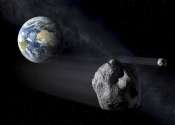Astronomers find that two exoplanets may be mostly water
A team led by UdeM astronomers has found evidence that two exoplanets orbiting a red dwarf star are "water worlds," planets where water makes up a large fraction of the volume. These worlds, located in a planetary system ...









